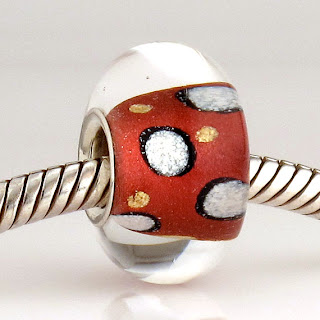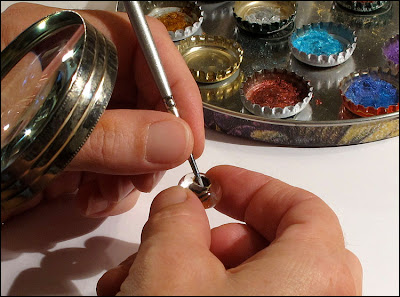These sparkly and festive lampwork beads are hand-painted with mica powders (a.k.a. pixie dust) and cored with sterling silver. They will fit Pandora® chains. Check my Etsy shop, they should be listed soon.
This idea went through many evolutions and trials and errors before I arrived at the style here. It's a really fun process and I'm totally obsessed with it!
How they're made:
First I use Double Helix Zephyr glass to make the clear beads. After they are annealed in the kiln and cleaned, I paint the insides of the holes with mica powders and acrylics. I use teeny tiny paint brushes and a magnifying glass. I leave the paints to cure for a couple of days, then cut sterling silver tubing to core the inside of each bead. Finally I give the silver a shiny polish and they're done! Below are some photos of the process.
Lampworking the bead. I think Zephyr is the best clear for this:
Measuring and cutting the sterling silver tubing. After this step, I use the Jim Moore Bead Press and silver-working tools to put the cores in the beads:
What is mica powder?
If you've ever been curious where pixie dust comes from and how it's colored and made, you can find some of that out on the Wikipedia page about mica here (just in case any of you are science and information geeks like me)!
Mica is found and mined in many places around the world. It comes in different forms like crystalline and sheet mica, but pixie dust is made from a powdered version called wet-ground mica. It gets its vivid range of colors by being coated with different thicknesses of TiO2 (titanium dioxide). Mica is chemically and electrically inert and can withstand very high temperatures. By the way, do you wear eyeshadow? Lipstick? Blush? Do you do drywall work, or house or automotive painting? Do you brush your teeth with sparkly white toothpaste? Then you use mica powder all the time!
I'm so excited to share these new beads with you!
"Like" my Facebook page to keep track of daily updates and new listings! http://www.facebook.com/beadabundant








8 comments:
What a great idea!!! And what a lot of tiny work - congratulation, they are beautiful!
Greetings from Austria, Michi
Thank you!
oh my - these are wonderful!!! Going off to "love" your FB page!
What am I talking about?! I already have you "loved" and have your beads - I didn't recognize your blog name, but now I want out these beads a little closer.
Not so many artisan lampwork beads would share their new discover =) it's very kind of you Karolen to share it with us.
May I know where I can buy the mica?
They are beautiful Karolen. I always thought of mica as being various shades of brown so these colours are a surprise! Thanks for showing how they were made - very clever and inventive.
Thanks Janet! And thanks Frances and Lili!
I suppose mica would be brown or colorless, until the titanium dioxide is added to color it.
When surfing around ebay and etsy for 'mica powder', I'm finding a lot of powders for people who make their own eyeshadow and makeup. I think eyeshadow is simply compressed mica powder, but i'm not sure! I don't know if the mica powders sold as eyeshadow would work to color my beads... i'm still experimenting with this!
I know you can find "pixie dust", which is simply the name for mica powder sold to glass workers, at any glass supply house such as Arrow Springs or ABR. "Pixie dust" is what I've purchased and used for these beads.
I've just given a brief overview of the techniques in this blog post, but I hope to get organized and get the rest of the details, tips and tricks out to you all soon.
Pretty good post.thanks for sharing wonderful post.
Post a Comment